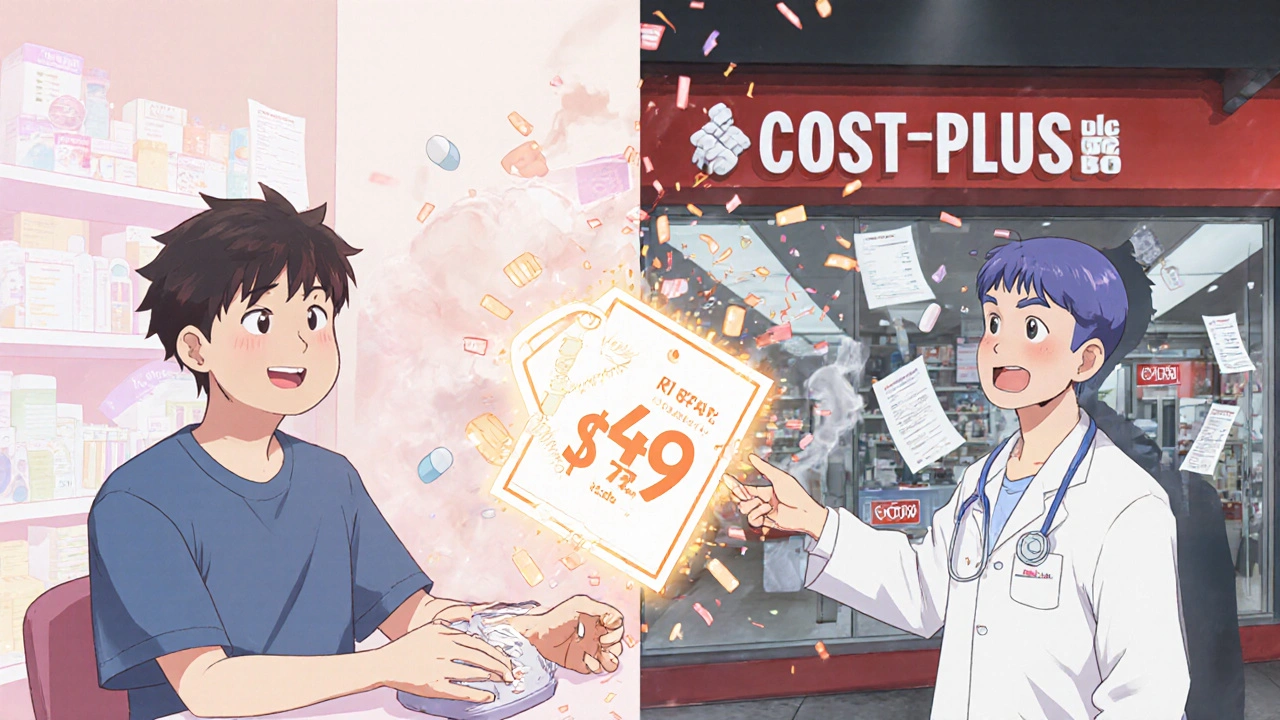When you fill a prescription for a generic drug like metformin or lisinopril, you might assume your insurance is getting you the best deal. But here’s the truth: your insurer is likely paying far more than it needs to - not because of the drug, but because of how it’s bought.
How Insurers Actually Buy Generic Drugs
Most insurers don’t buy drugs directly from manufacturers. Instead, they hire pharmacy benefit managers (PBMs) like OptumRx, Caremark, or Express Scripts to handle it. These middlemen negotiate prices, manage formularies, and set what pharmacies get paid. Sounds efficient? Not always. PBMs use a system called bulk buying and tendering to save money. That means they gather demand from millions of patients, then ask multiple generic drug makers to bid for the contract. The lowest bidder wins - and gets a guaranteed volume of sales. It’s like Costco buying toilet paper in bulk, but for pills. The savings can be massive. According to the Association for Accessible Medicines, generics made up 90% of all prescriptions in 2023 but only 17% of total drug spending. That’s because when multiple companies make the same drug, competition drives prices down. One study found that after a new generic hits the market, prices can drop by 80-90% within a year. For example, the first generic version of the heart drug bortezomib saved over $1 billion in its first 12 months.The Hidden Problem: Spread Pricing and Opaque Lists
Here’s where things get messy. Many PBMs don’t pass those savings on to insurers or patients. Instead, they use a practice called spread pricing. Let’s say a generic drug costs $2 at the manufacturer. The PBM tells the pharmacy to charge $10. The insurer pays $10, but the PBM only pays the pharmacy $5. The $5 difference? That’s the PBM’s profit. You never see it. You just see your $10 copay. Even worse, insurers often don’t know what’s really going on. PBMs use Maximum Allowable Cost (MAC) lists to cap how much they’ll pay for a generic. But these lists are secret. Insurers can’t see the real wholesale prices. So they think they’re saving money - when they’re actually subsidizing PBM profits. A 2022 JAMA Network Open study found that many insurers were paying more for certain generics than they would if they just paid cash at a pharmacy. One patient paid $87 through insurance for a generic blood pressure pill. At Cost Plus Drug Company, the same pill cost $4.99.Who’s Really Saving? The Patient or the Middleman?
It’s not just about the price. It’s about who benefits. Traditional PBM models prioritize drugs that give them the biggest rebate - even if those drugs cost more. That’s why some high-cost generics stay on formularies, even when cheaper, equally effective options exist. Insurers end up paying more, and patients pay higher copays. But a new wave of alternatives is changing the game. Companies like Cost Plus Drug Company and GoodRx cut out the middleman entirely. They buy directly from manufacturers, add a transparent 15% markup, and sell to consumers. No spreads. No secrets. Just prices you can see. A 2023 NIH study showed these direct-to-consumer models saved patients 76% on expensive generics and 75% on common ones. For many, that’s $200-$300 per prescription saved. Even Medicare is starting to catch on. In 2024, CMS required Medicare Part D plans to disclose PBM pricing details. And states like California passed laws forcing PBMs to reveal price differences that exceed 5%.
How Insurers Can Fix Their Generic Drug Strategy
If you’re an insurer or employer trying to cut costs, here’s what actually works:- Review your MAC lists quarterly. High-cost generics often have only one or two manufacturers. If there’s no competition, you’re paying a monopoly price.
- Require PBM transparency. Demand full access to the actual acquisition cost of every generic drug. If your PBM won’t share it, switch.
- Use therapeutic substitution. If two generics treat the same condition, choose the cheaper one - even if it’s from a lesser-known brand. Clinical studies show they’re just as safe.
- Partner with transparent pharmacies. Offer employees access to Cost Plus Drug Company, Navitus, or Blueberry Pharmacy. Many already save 60-90% compared to traditional pharmacies.
- Track which generics are costing the most. The JAMA study found that 10% of generic drugs accounted for 70% of spending. Find those outliers and replace them.
Why Some Generic Drugs Are Still Too Expensive
Not all generics are created equal. Some drugs have so few manufacturers that competition doesn’t exist. The FDA found that 80% of certain generic drugs are made by just three companies. When one shuts down - due to low prices, quality issues, or supply chain problems - the others raise prices. That’s what happened with albuterol inhalers in 2020. After prices dropped below production costs, manufacturers stopped making them. Hospitals reported shortages at 87% of facilities. The fix? Government intervention. The VA negotiates prices directly with makers and pays 24% less than Medicare Part D. The lesson? Bulk buying only works if there’s real competition. When there isn’t, you need to step in - or pay the price.
What Patients Can Do Right Now
You don’t have to wait for your insurer to fix things. Here’s what you can do today:- Always ask: "Can I pay cash?" For generics, cash is often cheaper than insurance.
- Use GoodRx or SingleCare. These apps show you the lowest price in your area - sometimes under $5.
- Check if your pharmacy offers a $4 list. Walmart, Kroger, and Target sell dozens of generics for $4-$10.
- Switch to a direct-to-consumer pharmacy like Cost Plus Drug Company if you take multiple generics.
The Bigger Picture: $445 Billion in Savings - But Who Gets It?
In 2023, generics saved the U.S. healthcare system $445 billion. That’s more than the GDP of most countries. Yet most of those savings never reached patients or employers. They stayed with PBMs, pharmacy chains, and insurers who didn’t demand transparency. The future of generic drug pricing is simple: either we fix the system - or we bypass it. Insurers that embrace transparent bulk buying, ditch spread pricing, and empower patients with cash-price options will save millions. And patients? They’ll finally get the savings they were promised all along.Why are generic drugs sometimes more expensive with insurance than without?
Because many pharmacy benefit managers (PBMs) use spread pricing - they charge your insurer more than they pay the pharmacy, keeping the difference as profit. The price you see at the counter may be inflated to cover that hidden markup. Paying cash or using a transparent service like Cost Plus Drug Company often costs far less.
What is bulk buying and tendering in the context of generic drugs?
Bulk buying and tendering is when insurers or PBMs pool together the demand for a specific generic drug from millions of patients, then invite multiple manufacturers to bid for the contract. The lowest bidder wins and supplies the drug at a discounted rate in exchange for guaranteed volume. This drives prices down through competition.
Do all generic drugs have the same effectiveness?
Yes. The FDA requires generic drugs to have the same active ingredient, strength, dosage form, and route of administration as the brand-name version. They must also meet the same strict standards for quality, purity, and performance. Differences in inactive ingredients (like fillers) don’t affect how well the drug works.
How can I find out if my generic drug is overpriced?
Use apps like GoodRx, SingleCare, or Cost Plus Drug Company to compare the cash price in your area. If your insurance copay is higher than the cash price, you’re likely overpaying. Ask your pharmacist for the cash price before using insurance - you can often choose to pay cash instead.
Are there risks to switching to a cheaper generic?
There’s no clinical risk. The FDA rigorously tests all generics for safety and effectiveness. The only potential issue is if you’re allergic to an inactive ingredient - which is rare. If you notice a change in how you feel after switching, talk to your doctor. But in most cases, switching to a lower-cost generic is not just safe - it’s smarter.
What’s the difference between a PBM and an insurer?
Your insurer (like Blue Cross or Aetna) pays for your healthcare coverage. A pharmacy benefit manager (PBM) - like OptumRx or Caremark - is a separate company hired by the insurer to manage your drug benefits. The PBM negotiates prices, sets formularies, and handles claims. But they often profit from hidden markups, not from lowering your costs.
Will switching to a transparent pharmacy affect my insurance coverage?
No. You can still use your insurance for brand-name drugs or specialty medications. But for generics, you can choose to pay cash at a transparent pharmacy like Cost Plus Drug Company or Blueberry Pharmacy - and it won’t affect your insurance benefits. Your insurer won’t even know you did it.

10 Comments
The whole system is rigged PBMs are just corporate vampires sucking blood from patients and insurers alike nobody talks about this because the money flows upward and the rest of us get the scraps
This is such an eye opener I had no idea how messed up the system was. Seriously if you’re paying $87 for a $5 pill you’re getting played. Start using GoodRx today your wallet will thank you
Always ask cash price. Always. I saved $120 last month just by switching my blood pressure med to cash at Walmart. PBMs don’t care about you
Man I used to think PBMs were some kind of efficiency wizards turns out they’re just fancy middlemen with a spreadsheet and zero ethics. I’m Irish and even we know when someone’s ripping you off and this is a full on heist. The fact that insurers don’t demand transparency is criminal. I’ve started paying cash for my generics now and I swear I feel lighter financially like I just shed a 20 pound backpack full of lies
MAC lists are a black box. Insurers need to demand full cost transparency or fire their PBM. Period. Direct-to-consumer models are the future
Interesting breakdown. I wonder how many employers are actually auditing their PBM contracts. Most just sign the paperwork and assume they’re getting value. The JAMA study findings are staggering. This isn’t just a patient issue it’s a corporate governance failure
It’s not just about cost. It’s about accountability. PBMs profit from opacity. Transparent pricing models like Cost Plus Drug Company prove that ethical drug distribution is possible. Insurers must prioritize patient outcomes over margin expansion.
Oh please. Another ‘pay cash’ lecture. You think people don’t know this already? The system is designed to confuse and exploit. Your $5 pill is a mirage. The real cost is embedded in your premiums. This isn’t a fix it’s a bandage on a severed artery.
I live in India and we have generic drugs for pennies here. But the same drugs in the US are priced like luxury goods. It’s not about production. It’s about power. Who controls the pipeline controls the people. And right now the pipeline is owned by a handful of corporate giants who don’t care if you die slowly from a $4 pill
so like… if i pay cash i still get my meds right? like no weird side effects? i just want to know if im gonna be fine or if im gonna turn into a zombie because i skipped insurance
Write a comment